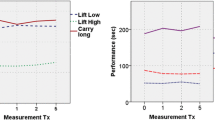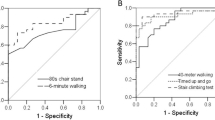Abstract
Introduction The Work Well Functional Capacity Evaluation (WW FCE) is a two-day performance based test consisting of several work-related activities. Three lifting and carrying test items may be performed on both days. The objective of this study was to assess the need for repeated testing of these items in subjects with early osteoarthritis of the hip and/or the knee and to analyze sources of variation between the 2 days of measurement. Methods A standardized WW FCE protocol was applied, including repeated testing of lifting low, lifting overhead and carrying. Differences and associations between the 2 days were calculated using paired samples t-tests, intraclass correlation coefficients (ICC) and limits of agreement (LoA). Possible sources of individual variation between the 2 days were identified by Wilcoxon signed ranks tests. Pearson correlation coefficients were calculated for differences in performances between days and differences in possible sources of variation between days. Results Seventy-nine subjects participated in this study, their mean (SD) age was 56.6 (4.8) years, median (min–max) WOMAC (Western Ontario and McMaster Universities) index scores for pain, stiffness and physical function were 5 (0–17), 3 (0–7) and 14 (0–49), respectively. Median (min–max) SF36 physical function was 75 (5–95), and SF36 pain score was 67 (12–76). Mean performance differences ranged from −0.2 to −0.8 kg (P > 0.05). ICC’s ranged from 0.75 (lifting overhead) to 0.88 (lifting low). LoA were: lifting low 8.0 kg; lifting overhead 6.5 kg; carrying 9.0 kg. Pearson’s correlations were low and non-significant. Conclusions All three tests show acceptable two-day consistency. WW FCE testing on two consecutive days is not necessary for groups of subjects with early osteoarthritis. Individual sources of variation could not be identified.

Similar content being viewed by others
References
Arden N, Nevitt MC. Osteoarthritis: epidemiology. Best Pract Res Clin Rheumatol. 2006;20(1):3–25.
Corti MC, Rigon C. Epidemiology of osteoarthritis: prevalence, risk factors and functional impact. Aging Clin Exp Res. 2003;15(5):359–63.
Altman R, Alarcon G, Appelrouth D, Bloch D, Borenstein D, Brandt K, et al. The American College of Rheumatology criteria for the classification and reporting of osteoarthritis of the hip. Arthritis Rheum. 1991;34(5):505–14.
Pincus T, Mitchell JM, Burkhauser RV. Substantial work disability and earnings losses in individuals less than 65 with osteoarthritis: comparisons with rheumatoid arthritis. J Clin Epidemiol. 1989;42:449–57.
Hopman-Rock M, Kraaimaat FW, Bijlsma JWJ. Quality of life in elderly subjects with pain in hip or knee. Qual Life Res. 1997;6:67–76.
Salaffi F, Carotti M, Stancati A, Grassi W. Health-related quality of life in older adults with symptomatic hip and knee osteoarthritis: a comparison with matched healthy controls. Aging Clin Exp Res. 2005;17(4):255–63.
Bellamy N. Osteoarthritis clinical trials: candidate variables and clinimetric properties. J Rheumatol. 1997;24:768–78.
Bellamy N, Kirwan J, Boers M, Brooks P, Strand V, Tugwell P, et al. Recommendations for a core set of outcome measures for future phase III trials in knee, hip, and hand osteoarthritis. Consensus development at OMERACT III. J Rheumatol. 1997;24:799–802.
Steultjens MP, Roorda LD, Dekker J, Bijlsma JW. Responsiveness of observational and self-report methods for assessing disability in mobility in patients with osteoarthritis. Arthritis Rheum. 2001;45:56–61.
Reneman MF, Jorritsma W, Schellekens JMH, Göeken LNH. Concurrent validity of questionnaire and performance based disability measurements in patients with chronic low back pain. J Occup Rehabil. 2002;12:119–29.
Stratford PW, Kennedy DM. Performance measures were necessary to obtain a complete picture of osteoarthritic patients. J Clin Epidemiol. 2006;59(2):160–7.
Stratford PW, Kennedy DM, Woodhouse LJ. Performance measures provide assessments of pain and function in people with advanced osteoarthritis of the hip and knee. Phys Ther. 2006;86(11):1489–96.
Abdel-moty E, Fishbain DA, Khalil TM, Sadek S, Cutler R, Rosomoff RS, et al. Functional capacity and residual functional capacity and their utility in measuring work capacity. Clin J Pain. 1993;9:2003–13.
King PM, Tuckwell N, Barrett TE. A critical review of functional capacity evaluations. Phys Ther. 1998;78:852–66.
Gross DP, Battie MC. Construct validity of a kinesiophysical functional capacity evaluation administered within a worker’s compensation environment. J Occup Rehabil. 2003;13(4):287–95.
Reneman MF, Jorritsma W, Dijkstra SJ, Dijkstra PU. Relationship between kinesiophobia and performance in a functional capacity evaluation. J Occup Rehabil. 2003;13(4):277–85.
Brouwer S, Dijkstra PU, Stewart RE, Goeken LN, Groothoff JW, Geertzen JH. Comparing self-report, clinical examination and functional testing in the assessment of work-related limitations in patients with chronic low back pain. Disabil Rehabil. 2005;27(17):999–1005.
Reneman MF, Dijkstra PU, Westmaas M, Göeken LNH. Test–retest reliability of lifting and carrying in a 2-day functional capacity evaluation. J Occup Rehabil. 2002;12:269–75.
Brouwer S, Reneman MF, Dijkstra PU, Groothoff JW, Schellekens JM, Goeken LN. Test–retest reliability of the Isernhagen work systems functional capacity evaluation in patients with chronic low back pain. J Occup Rehabil. 2003;13(4):207–18.
Reneman MF, Brouwer S, Meinema A, Dijkstra PU, Geertzen JH, Groothoff JW. Test–retest reliability of the Isernhagen work systems functional capacity evaluation in healthy adults. J Occup Rehabil. 2004;14(4):295–305.
Wesseling J, Dekker J, Van den Berg WB, Bierma-Zeinstra SM, Boers M, Cats HA, et al. CHECK: Cohort Hip & Cohort Knee; similarities and differences with the OA initiative. Ann Rheum Dis 2008; 4. doi:10.1136/ard.2008.096164.
McGraw KO, Wong SP. Forming inferences about some intraclass correlation coefficients. Psychol Methods. 1996;1(1):30–46.
Lee J, Koh D, Ong CN. Statistical evaluation of agreement between two methods for measuring quantitative variable. Comput Biol Med. 1989;19:61–70.
Bland JM, Altman DG. Statistical methods for assessing agreement between two methods of clinical measurement. Lancet. 1986;8:307–10.
Functional Capacity Evaluation Manual. Duluth, Minn: Isernhagen Work Systems; 1997.
US Department of Labor Employment and Training Administration. Dictionary of occupational titles. 4th ed. Washington, DC: US Department of Labor; 1991.
Leardini G, Salaffi F, Caporali R, Canesi B, Rovati L, Montanelli R, et al. Direct and indirect costs of osteoarthritis of the knee. Clin Exp Rheumatol. 2004;22(6):699–706.
Rabenda V, Manette C, Lemmens R, Mariani AM, Struvay N, Reginster JY. Direct and indirect costs attributable to osteoarthritis in active subjects. J Rheumatol. 2006;33(6):1152–8.
Author information
Authors and Affiliations
Corresponding author
Rights and permissions
About this article
Cite this article
van Ittersum, M.W., Bieleman, H.J., Reneman, M.F. et al. Functional Capacity Evaluation in Subjects with Early Osteoarthritis of Hip and/or Knee; is Two-Day Testing Needed?. J Occup Rehabil 19, 238–244 (2009). https://doi.org/10.1007/s10926-009-9179-y
Received:
Accepted:
Published:
Issue Date:
DOI: https://doi.org/10.1007/s10926-009-9179-y




